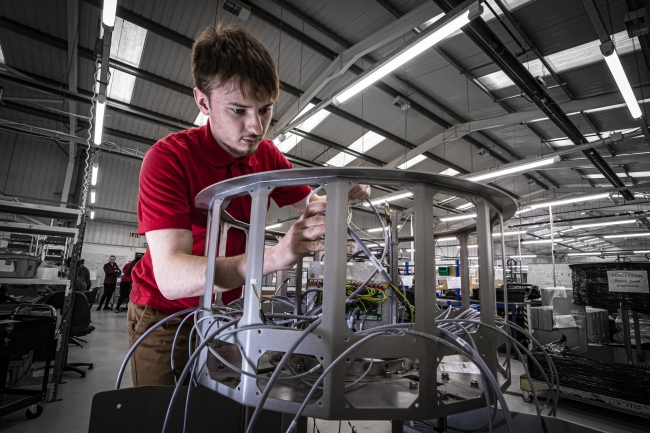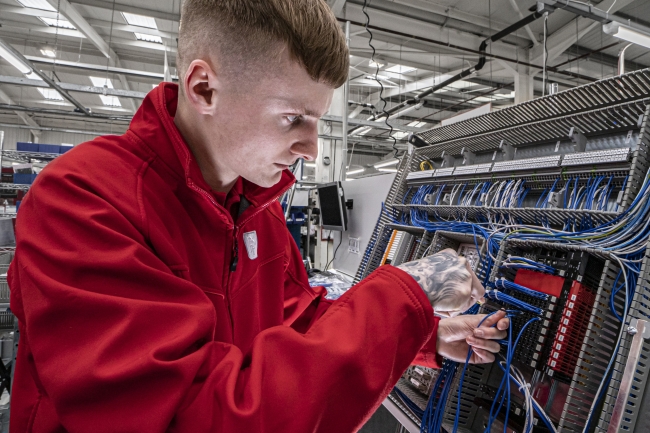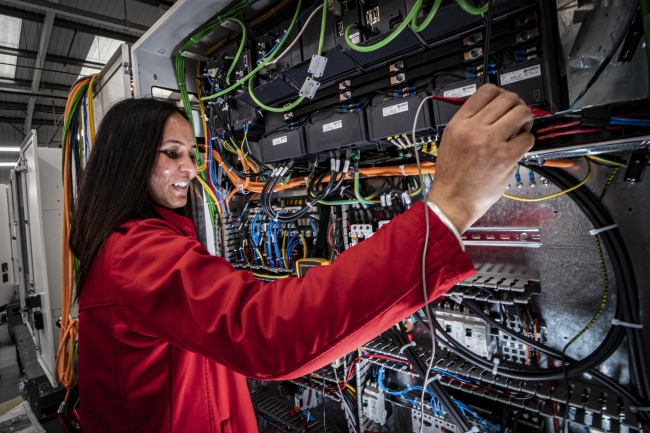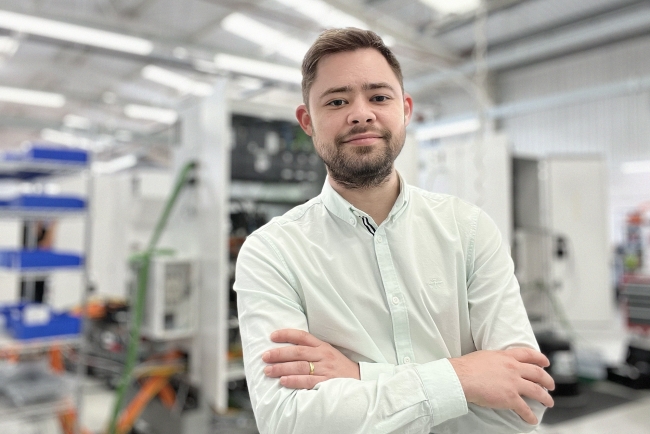10 minute read • published in partnership with PP Control & Automation
Insight: A blueprint for better collaboration
Richard Spears is marketing manager at PP Control & Automation, and the brains behind PP Plus, a new collaborative network designed to help green technological innovation take root in the UK. In an exclusive for Zenoot, he explores why collaboration is the growth-hack that UK manufacturers should be exploiting more.
When it comes to exploring the many opportunities for growth across the UK manufacturing community, no matter what corners we poke in or subject we delve, one thing routinely makes itself known…the power of collaboration. It is central to how we solve our biggest problems and central to how we take advantage of our biggest opportunities, whether you are entering emerging markets or adopting new technologies, attracting and retaining talent, or maximising efficiencies and productivity
But are we as effective as we can be at working together?
There is a documentary I would like to reference at this point; something we can use to influence our collective approach and inspire a blueprint for better collaboration. Where to Invade Next is a 2015 documentary film by Michael Moore. In the film, the American director visits several countries and examines aspects of their social policies that he suggests the United States could adopt.
What if we borrowed this concept? What, if by understanding what works across other regions, successful approaches can be combined to build a collaboration blueprint for UK manufacturers to call their own? Integrating the best elements and practices from around the world is a complex task, but someone needs to start somewhere, so here goes.

Collaboration is the growth-hack that UK manufacturers should be exploiting more / Picture: PPC&A
Invading for ideas and a 12-point framework
There are countless examples of successful and purposeful collaboration in practice everywhere – from Mittelstand in Germany and Keiretsu in Japan to the tech giants in Silicon Valley. Between them all, there are several commonalities.
One: All these concepts or structures are associated with a strong focus on long-term planning and stability. Two: They involve close collaboration and cooperation between companies within the same network or industry. Three: Each of these structures or regions has had a significant impact on their respective national or global economies.
These organisational and economic concepts and structures represent different approaches to business organisation and management, each with unique strengths. And a uniqueness that could be tapped into to form a comprehensive collaboration framework for the UK manufacturing sector.
To support growth and competitiveness, 12 points of consideration emerge whereby the art of collaboration will impact success. At least that would seem to be the case when reviewing other successful approaches both here and overseas. Let’s look at those dozen points and determine where we need to develop, improve, or ramp-up our strategies.
1 – Government support & policies
Establish a conducive regulatory and policy environment to support manufacturing innovation and collaboration. Incentivise research and development through tax breaks and grants. Create long-term industrial plans with clear objectives, such as energy sustainability or digitalisation.
2 – Industry clusters & hubs
Foster the creation of regional manufacturing clusters, similar to Germany’s Mittelstand, where small and medium-sized enterprises (SMEs) cooperate and share resources.
Promote co-location of manufacturers, suppliers, and research institutions in these clusters.
3 – Collaborative supply chains
Encourage the development of Keiretsu-like supplier networks, where manufacturers and suppliers have close, long-term relationships, leading to shared goals and knowledge exchange.
4 – Technology & innovation
Emulate Silicon Valley’s culture of innovation by establishing innovation hubs and technology parks. Promote collaboration with universities and research institutions for technology transfer.
5 – Green manufacturing & sustainability
Learn from Denmark’s Renewable Energy Collaboration to drive sustainability initiatives. Encourage manufacturers to adopt eco-friendly practices and renewable energy sources.
6 – High-tech manufacturing
Develop a high-tech manufacturing ecosystem like Singapore’s High-Tech Manufacturing Hub. Promote the adoption of Industry 4.0 technologies and automation.
7 – Open innovation & design
Incorporate elements of ODM (Original Design Manufacturer) to encourage collaboration in product design. Create platforms for open innovation, allowing manufacturers to share and co-develop designs.
8 – Skills development & education
Invest in a robust education and training system to equip the workforce with the skills needed for advanced manufacturing. Promote apprenticeship programmes and vocational training.
9 – International collaboration
Engage in international partnerships and trade agreements to expand market access and learn from global best practices. Promote exports through trade missions and diplomatic channels.
10 – Continuous improvement & benchmarking
Implement regular performance benchmarking and best practice sharing across manufacturing sectors. Establish a culture of continuous improvement, as you see with the Japanese Kaizen philosophy.
11 – Financial support & access to capital
Provide access to affordable financing options for manufacturers, similar to the Chaebol model in South Korea, but without inheriting the controversial issues related to corporate governance and the concentration of power. Encourage venture capital and private equity investment in the manufacturing sector.
12 – Quality assurance & certification
Develop a robust quality assurance and certification system, such as ISO standards. This will build trust and credibility in UK-made products.

There are successful and purposeful collaborations in practice everywhere – from Mittelstand in Germany and Keiretsu in Japan to the tech giants in Silicon Valley / Picture: PPC&A
Of course, even with this 12-point framework in place, the success of any collaboration blueprint will depend on strong leadership, effective public-private partnerships, and a commitment to adapt to changing economic and technological landscapes.
Let’s now take a minute to dive a little deeper into some of the regional approaches that have inspired this framework. It will help us determine how and why they are as successful as they are.
Joining the dots
The Mittelstand, representing small and medium-sized enterprises (SMEs) in Germany, typically consists of companies with fewer than 500 employees. These businesses are often family-owned and emphasise long-term sustainability and continuity across generations, fostering a strong sense of responsibility and dedication as well as a culture of innovation, quality, and long-term thinking.
Mittelstand companies often form regional clusters, which are networks of interconnected firms, suppliers, and service providers within specific industries. These clusters promote collaboration, knowledge sharing, and specialisation, thereby enhancing efficiency and competitiveness. By focusing on niche markets, Mittelstand firms produce high-quality, specialised products and can quickly adapt to market changes.
The German education system, with its emphasis on vocational training and apprenticeships, ensures a highly skilled workforce that contributes to the innovation and quality these companies are known across the world for. Mittelstand firms also invest heavily in research and development (R&D), frequently collaborating with universities, research institutions, and other companies.
This collaborative approach builds strong networks and provides access to larger markets. Financially prudent, these companies grow through retained earnings and long-term investments, contributing to their resilience and global competitiveness. Export orientation is also common, with many targeting high-value markets. Supportive government policies, including grants, loans, and favourable regulations, further encourage entrepreneurship, innovation, and investment in the Mittelstand.
Originating in Japan, Keiretsu supplier networks involve close, long-term relationships between a central large corporation and its suppliers. These networks, built on trust and long-term partnerships, ensure stability and predictability in the supply chain. They promote collaboration, leading to cost savings through shared decision-making in product development, quality standards, and cost management.
High-quality standards and continuous improvement are integral to this model, with the parent corporation actively supporting suppliers in achieving these standards. By maintaining close relationships and collaborating on production and demand forecasting, Keiretsu networks effectively manage supply chain risks.
Silicon Valley in Northern California is renowned for its culture of innovation, driven by a spirit of entrepreneurship that encourages risk-taking and the pursuit of innovative ideas. There is a strong tolerance for failure, viewing it as a learning experience. The region offers access to a vast network of venture capitalists, angel investors, and other financial resources essential for startups. Open sharing of information and ideas leads to cross-pollination of knowledge, and networking events, incubators, and accelerators facilitate interactions among startups, established companies, and support services.
Proximity to leading universities like Stanford and UC Berkeley supplies a steady stream of skilled professionals. Innovation hubs and incubators provide early-stage businesses with mentorship, resources, and networking opportunities. The cultural diversity of Silicon Valley brings varied perspectives, leading to creative solutions and adaptability to changing market conditions.

Collaboration is central to how we solve our biggest problems and central to how we take advantage of our biggest opportunities / Picture: PPC&A
Denmark’s success in renewable energy and sustainability is due in part to its Renewable Energy Collaboration model, which involves a combination of government policies, industry collaboration, and technological innovation. The government’s commitment is evident in ambitious targets for reducing greenhouse gas emissions and increasing renewable energy.
Denmark’s Energy Agreement outlines a comprehensive strategy for transitioning to a green energy system. Strong partnerships between the public sector, private industry, and research institutions drive innovation and sustainability initiatives. Denmark is a global leader in wind energy technology, particularly offshore wind, with significant investments in R&D and deployment. Market mechanisms like feed-in tariffs and green certificates incentivise renewable energy production and consumption. Clear policy objectives, public support, and collaboration contribute to Denmark’s leadership in this field.
Singapore has established itself as a global leader in high-tech manufacturing through specialised manufacturing hubs and industrial parks. Government support, strategic location, a skilled workforce, and world-class infrastructure are key factors in this success. High-tech hubs, such as Jurong Island, Tuas Biomedical Park, Woodlands Wafer Fab Park, Seletar Aerospace Park, and CleanTech Park, focus on various industries including petrochemicals, pharmaceuticals, semiconductors, aerospace, and green manufacturing.
The government provides incentives and a conducive business environment, with agencies like the Economic Development Board actively promoting and attracting investments. Singapore’s strategic location enhances accessibility to raw materials and distribution networks, while its world-class infrastructure supports manufacturing operations. Collaboration between research institutes, universities, and technology parks fosters innovation, and the protection of intellectual property rights makes Singapore attractive for technology-intensive manufacturing. The ease of doing business, supported by a transparent regulatory framework and minimal bureaucracy, amplifies the benefits of this Asian superpower’s high-tech ecosystem.
In Taiwan, Original Design Manufacturer (ODM) collaborations involve partnerships between companies specialising in product design and manufacturing and brands looking to bring new products to market. Successful collaborations align the goals and vision of both the brand and the ODM, with clear communication, shared innovation, and quality assurance being vital.
Market orientation ensures that product development is well-aligned with market demands and consumer preferences. By leveraging market and consumer insights, these collaborations prioritise customer-centricity, deep market insights, brand integration, and customer-focused innovation, achieving successful product launches and maintaining productive long-term partnerships.
Chaebol in South Korea is another interesting model, involving large, family-controlled conglomerates with diverse business interests. It has been successful in delivering affordable financing options for manufacturers, whereby economies of scale, financial synergy, and government support contribute to this success.
Internal financing within the conglomerate, access to favourable external financing, and long-term investment approaches make financing more affordable. Chaebols’ global presence and strong creditworthiness allow them to secure cost-effective financing for manufacturing operations, ensuring financial stability and growth.
This synthesis captures the essence and key themes of regional business models, highlighting their unique characteristics, strategies, and successes in fostering innovation, collaboration, and competitiveness.
Coming together
At this point, you may be thinking that many of these approaches exist in the UK already; that there are countless examples of excellent supply chain collaboration, R&D partnerships, and industry clusters. And whilst our government’s appreciation (and most likely our next government’s appreciation) for a robust industrial strategy to boost UK performance is lacking, there are very successful funded programmes, such as Innovate UK or sector-specific initiatives like the Agri-Tech Centres.
It is not to say that the UK lacks the understanding or is unaware of the benefits behind strategic collaboration, but rather that the strategy itself is too loose. Perhaps much of the good things we have currently, are operating in silos, with separate agendas.

Richard Spears, marketing manager at PP Control & Automation / Picture: PPC&A
Perhaps, if we were to play devil’s advocate, we would say that the UK’s efforts are too fragmented. It is alignment of the many initiatives and efforts where we need to make improvements. It would also be fair to say that in comparison to the region’s we’ve analysed here; that investment is limited, we are more risk adverse, there are too many regulatory barriers and cultural or organisational barriers. Perhaps there is a lack of trust between companies hindering proper knowledge sharing, and competitive pressures exist that deter businesses from openly collaborating.
When combined, these factors can create an environment in which successful collaboration in UK manufacturing is challenging. As a nation, we need to tighten our position on what we’re attempting to achieve through collaboration, and importantly come together to realise the opportunity.
Where to Invade Next by Michael Moore concludes on an optimistic note. In the final scenes of the film, Moore reflects on his journey through various countries, where he attempted to learn about their social and political policies. He emphasises the idea that the United States can learn from these other countries and adopt some of their policies and practices to improve quality of life. This opinion piece will end with a similar call to action.
As a manufacturing community, what can we do to create a better future? If collaboration is the secret to success, unlocking emerging market opportunities, championing sustainability, driving investment in robotics and automation, green technology, clean energy and mobility, advocating for sustainable consumption and contributing to a circular economy; then what are we waiting for?
At PP Control & Automation, we’re no strangers to collaboration. We were a founding member of the Manufacturing Assembly Network (MAN) and founder of UKMFG Unite, which was a response to the challenges facing industry during Covid-19 and encouraged UK manufacturers to work together to take advantage of a once in a lifetime reshoring opportunity.
More recently, the PP Plus initiative has brought together over 20 organisations from across manufacturing, business, and academia to help support green technological innovation scale. Behind the scenes, sector-specific collaborations are forming to maximise opportunities in clean energy and agricultural technology. We’re borrowing the best ideas from all over the world to futureproof our own success, and we’re bringing as many like-minded organisations as possible together to enjoy the ride with us.
A collaboration blueprint has been in front of us all along. We just needed to join the dots.
